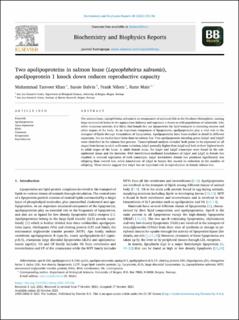| dc.contributor.author | Khan, Muhammad Tanveer | |
| dc.contributor.author | Dalvin, Sussie | |
| dc.contributor.author | Nilsen, Frank | |
| dc.contributor.author | Male, Rune | |
| dc.date.accessioned | 2021-11-05T13:03:34Z | |
| dc.date.available | 2021-11-05T13:03:34Z | |
| dc.date.created | 2021-10-25T10:24:47Z | |
| dc.date.issued | 2021 | |
| dc.identifier.citation | Biochemistry and Biophysics Reports. 2021, 28 . | en_US |
| dc.identifier.issn | 2405-5808 | |
| dc.identifier.uri | https://hdl.handle.net/11250/2828178 | |
| dc.description.abstract | The salmon louse, Lepeophtheirus salmonis is an ectoparasite of salmonid fish in the Northern Hemisphere, causing large economical losses in the aquaculture industry and represent a threat to wild populations of salmonids. Like other oviparous animals, it is likely that female lice use lipoproteins for lipid transport to maturing oocytes and other organs of the body. As an important component of lipoproteins, apolipoproteins play a vital role in the transport of lipids through biosynthesis of lipoproteins. Apolipoproteins have been studied in detail in different organisms, but no studies have been done in salmon lice. Two apolipoprotein encoding genes (LsLp1 and LsLp2) were identified in the salmon lice genome. Transcriptional analysis revealed both genes to be expressed at all stages from larvae to adult with some variation, LsLp1 generally higher than LsLp2 and both at their highest levels in adult stages of the louse. In adult female louse, the LsLp1 and LsLp2 transcripts were found in the sub-epidermal tissue and the intestine. RNA interference-mediated knockdown of LsLp1 and LsLp2 in female lice resulted in reduced expression of both transcripts. LsLp1 knockdown female lice produced significantly less offspring than control lice, while knockdown of LsLp2 in female lice caused no reduction in the number of offspring. These results suggest that LsLp1 has an important role in reproduction in female salmon lice. | en_US |
| dc.language.iso | eng | en_US |
| dc.title | Two apolipoproteins in salmon louse (Lepeophtheirus salmonis), apolipoprotein 1 knock down reduces reproductive capacity | en_US |
| dc.type | Peer reviewed | en_US |
| dc.type | Journal article | en_US |
| dc.description.version | publishedVersion | en_US |
| dc.source.pagenumber | 11 | en_US |
| dc.source.volume | 28 | en_US |
| dc.source.journal | Biochemistry and Biophysics Reports | en_US |
| dc.identifier.doi | 10.1016/j.bbrep.2021.101156 | |
| dc.identifier.cristin | 1948154 | |
| dc.relation.project | Norges forskningsråd: 203513 | en_US |
| cristin.ispublished | true | |
| cristin.fulltext | original | |
| cristin.qualitycode | 1 | |
